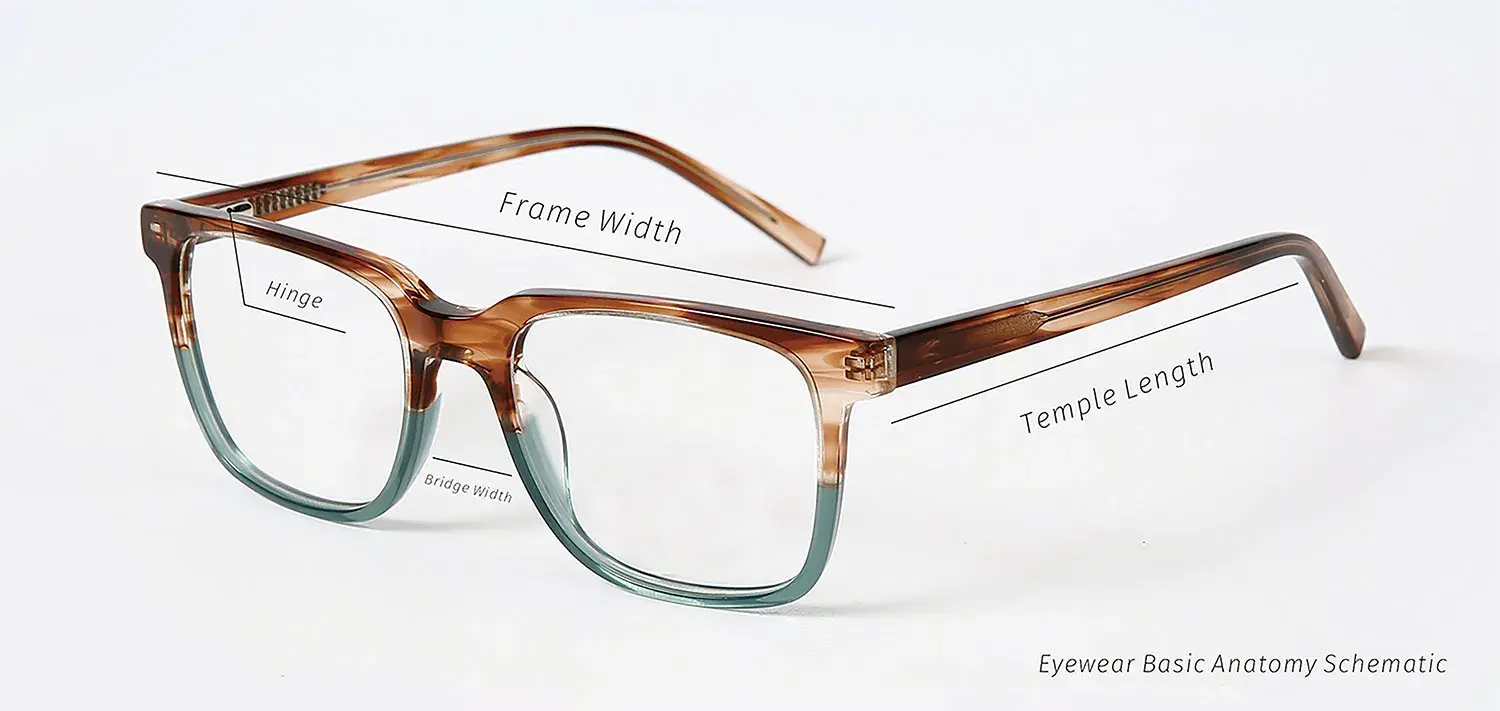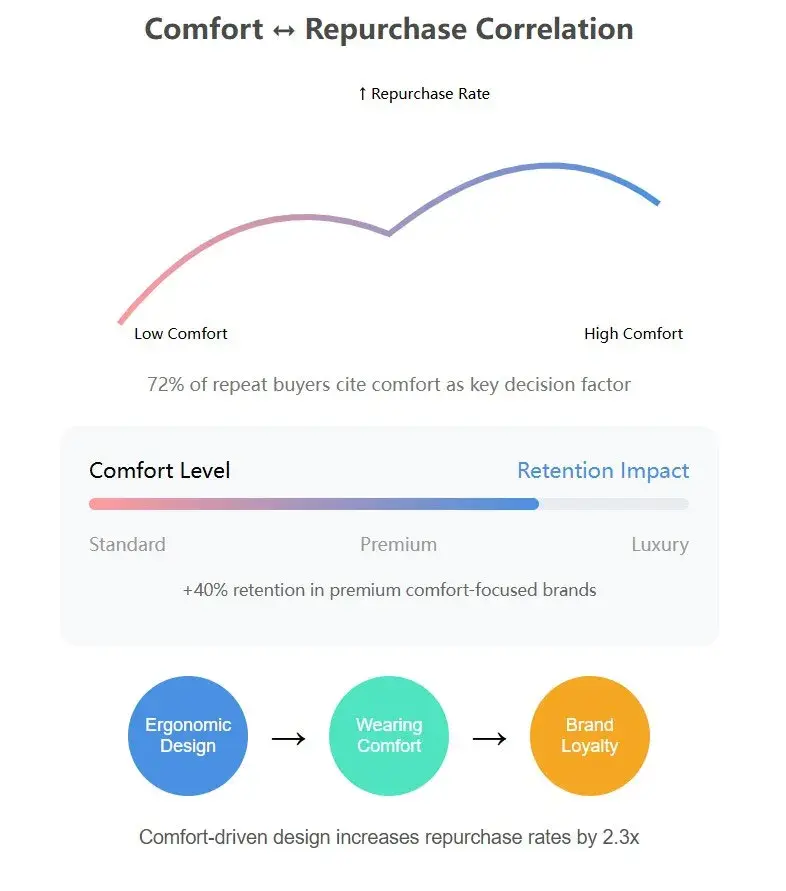Eyeglass Frame Size Guide: Understanding Frame Width, Bridge, and Temple Measurements for a Perfect Fit
The comfort and fit of an eyeglass frame rely on the precise coordination of several key components, especially the nose pads, eyewire, temples, and hinges. These elements define how well a frame sits on your face and whether it can be worn comfortably throughout the day.
As the primary contact point on the nasal bridge, nose pads play a critical role in both support and pressure distribution. The shape, material, and tilt angle of the pads are particularly important for individuals with higher nasal bridges—common among European face profiles. A poor nose pad fit can result in discomfort or slippage, making this a vital measurement consideration.
The eyewire width and curvature must align with the wearer’s face width. Frames that are too narrow can cause pinching at the temples, while overly wide frames may fail to rest properly on the ears. Proper sizing ensures the temples anchor securely, supporting long-term stability.
The temple length—measured from the hinge screw to the temple tip—also affects comfort. Correct temple sizing allows the arms to naturally curve around the ears without creating pressure points. This is especially important when fitting men’s eyeglass frames, as larger head widths require longer temples with a more ergonomic bend.
Lastly, hinges, though often overlooked, are critical to flexibility and overall durability. Loose hinges may lead to poor fit, while overly stiff ones can cause stress on the temple area. A well-balanced hinge ensures the frame adjusts to subtle head movements without sacrificing structure.

Influence of eyeglass size on wearing comfort
The comfort of eyeglasses is closely tied to the precise fit of their dimensions, particularly for Europeans, whose facial features demand more refined adjustments in bridge width, frame width, and temple length. Europeans typically have a high, narrow nasal bridge, and if the bridge width is improperly designed, it can cause excessive pressure on the nasal wings or poor stability, directly impacting wearability. If the nose pad dimensions do not accommodate the curvature of a high nasal bridge, the glasses may slide down or create localized pressure, leading to long-term discomfort.
The frame width is equally critical in ensuring a proper fit. Europeans' broader zygomatic bones and pronounced facial structure require sufficient lateral dimensions in the frame. If the frame width is too narrow, the temples may exert excessive pressure on the temporal region, or the frame may fail to conform to the head’s contour. Insufficient frame width concentrates pressure on the nose pads, reducing comfort, while an excessively wide frame prevents the temples from securely hooking behind the ears, compromising stability. Therefore, the frame width must precisely match the facial skeletal structure to ensure even weight distribution and avoid localized pressure points.
The temple length significantly influences retention and long-term comfort. Europeans generally have a larger head circumference, so temples that are too short can cause a pinching sensation, while overly long temples fail to anchor properly behind the ears. Additionally, Europeans’ ear attachment points tend to be positioned further back, requiring the temple bend to be adjusted forward for a natural fit along the helical curve, minimizing friction and slippage. An optimal temple length enhances stability and improves pressure distribution, preventing fatigue during prolonged wear.
Children's Eyewear Recommended Dimensions
Frame Width Recommended range: 120-135mm
Bridge Width Recommended range: 14-16mm
Temple Length Recommended range: 120-130mm
Adult Eyewear Recommended Dimensions
Frame Width Recommended range: 135-150mm (narrower for females, wider for males)
Bridge Width Recommended range: 18-22mm
Temple Length Recommended range: 140-150mm
Standardization Rationale for Dimension Ranges
Anthropometric Data: Derived from European craniofacial databases (e.g., CE standards) through big data analysis.
Manufacturing Standardization: Streamlines production while covering 90% of the population, reducing both production costs and consumer customization burdens.
Clinical Validation: Pressure mapping confirms optimal comfort parameters within these ranges.
Relationship between comfort and brand repurchase rate
The correlation between ocular comfort and brand repurchase rate demonstrates a significant positive relationship, which is fundamentally rooted in consumers' comprehensive evaluation of long-term wearing experience. When eyewear excels in key comfort metrics such as nasal pad pressure distribution, temple ergonomic fit, and frame weight balance, wearers tend to develop strong product dependency. This physiological comfort ultimately translates into brand technical trust.
Market analytics indicate that brands investing in human-centric design R&D achieve notably higher customer retention rates than industry averages. This phenomenon occurs because comfort performance, as a subjective yet critical experience metric, creates competitive differentiation once recognized by consumers. Particularly for full-time wearers, even minute variations in nasal bridge pressure or auricular contact points become magnified over prolonged use. This continuous wear dynamic makes comfort optimization a decisive factor in repurchase behavior.
Leading premium eyewear brands have successfully cultivated loyal customer bases by implementing customizable nose pad systems, flexible hinge mechanisms, and ultralight material technologies - all engineered to enhance wearability. This approach not only strengthens consumer loyalty but also increases the brand's procurement volume with suppliers. In the eyewear sector, superior comfort transcends being merely a basic product attribute; it serves as both a key driver of repurchase rates and a critical retention factor for supplier partnerships. The integration of comfort-driven design with supply chain collaboration creates a virtuous cycle that reinforces brand value across the entire product ecosystem.

The precise dimensional parameters of eyewear - including frame width, bridge width, and temple length - constitute critical determinants of optimal ocular comfort. Through comprehensive understanding of these key measurements' ergonomic implications, both optical suppliers and end-users can make informed selections to achieve superior wearing experiences.
Proper dimensional matching not only enhances daily comfort performance but also extends wearing duration while minimizing adjustment or replacement requirements caused by fitting discomfort. Whether for routine eyewear or specialized optical applications, accurate dimensional alignment serves as the fundamental prerequisite for ideal adaptation.
Consequently, meticulous attention to these dimensional specifications during selection processes is imperative to ensure perfect equilibrium between wearing comfort and functional performance.